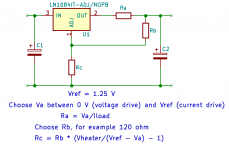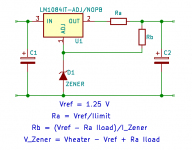The upper right side of this article shows how to current regulate a filament using a voltage regulator as a CCS.
http://www.tubecad.com/july2000/page6.html
Let's say the tube specification draws 800ma at 6.3 volts after reaching temperature. So I set my regulator to 800ma. Will the voltage across the tube be 6.3 volts after its hot even though the current source IN is 10 volts here? Because, well, ohms law. It's really not necessary to regulate both the voltage and the current as long as I'm regulating one of them the other will automatically adjust to what the tube needs, correct?
I want to limit current so the filament will last longer due to no inrush, because a cold filament has very low resistance. Most filaments like light bulbs burn out at start up.
But was wondering if my basic ohms law is right here.
http://www.tubecad.com/july2000/page6.html
Let's say the tube specification draws 800ma at 6.3 volts after reaching temperature. So I set my regulator to 800ma. Will the voltage across the tube be 6.3 volts after its hot even though the current source IN is 10 volts here? Because, well, ohms law. It's really not necessary to regulate both the voltage and the current as long as I'm regulating one of them the other will automatically adjust to what the tube needs, correct?
I want to limit current so the filament will last longer due to no inrush, because a cold filament has very low resistance. Most filaments like light bulbs burn out at start up.
But was wondering if my basic ohms law is right here.
You can't regulate both the current and the voltage at the same time. Regulating either one
will work for a tube, but the current is more directly related to emission. The voltage will vary
a bit in that case, but that is ok.
will work for a tube, but the current is more directly related to emission. The voltage will vary
a bit in that case, but that is ok.
Last edited:
You can't regulate both the current and the voltage at the same time. Regulating either one
will work for a tube, but the current is more directly related to emission. The voltage will vary
a bit in that case, but that is ok.
Thanks, I'll have to breadboard this to prove it to myself. So if I current regulate a tube rated to draw 500ma at 6.3 volts, to a CCS also set to 500ma. Then when that tube has finished heating up, I should measure a voltage of approximately 6.3 volts across it? Because that is its normal spec. And the tube would have heated itself up with no inrush at the start correct?
Correct. However, the final heater temperature is a bit more reproducible when you use a voltage regulator with a current limit than when you use a real current source.
That's because the resistance of the heater has a positive temperature coefficient. Suppose that due to some disturbance or other, the temperature is somewhat too high. The resistance of the heater will then become slightly higher than its normal value. When driven with voltage, this causes a reduction of the power dissipated in the heater (P = V^2/R), when driven with current, it causes an increase of the power (P = I^2 R) that further heats up the heater.
That's because the resistance of the heater has a positive temperature coefficient. Suppose that due to some disturbance or other, the temperature is somewhat too high. The resistance of the heater will then become slightly higher than its normal value. When driven with voltage, this causes a reduction of the power dissipated in the heater (P = V^2/R), when driven with current, it causes an increase of the power (P = I^2 R) that further heats up the heater.
Correct. However, the final heater temperature is a bit more reproducible when you use a voltage regulator with a current limit than when you use a real current source.
How do I make a voltage regulator with a current limit?
Or is it as simple as using voltage regulator that outputs something over 6.3 volts, then I use a resistor to bring it back down to 6.3 to get a kind of current limiting? Can someone point me to a schematics of how to set up an IC voltage regulator with a current limit? Would that be in the application notes for lets say an LM1084 (1.2-15V / 5A adjustable regulator)?
How do I set the upper current limit with one of these regulators to both stop the inrush and get the other benefit of a predictable temperature through voltage regulation?
A higher voltage and a simple series resistor will work, although you probably waste a lot of power in it.
Some regulators have an adjustable current limit, but the LM1084 not. There are several workarounds, see the attachments. The one without Zener diode uses a combination of series and shunt feedback to make something in between a voltage and a current source - essentially the same as a series resistor after the regulator, but with less power dissipation.
The one with a Zener should work better than the one without Zener. It makes the voltage between the ADJ pin and ground less dependent on the load current, until the load gets very close to the limit.
Some regulators have an adjustable current limit, but the LM1084 not. There are several workarounds, see the attachments. The one without Zener diode uses a combination of series and shunt feedback to make something in between a voltage and a current source - essentially the same as a series resistor after the regulator, but with less power dissipation.
The one with a Zener should work better than the one without Zener. It makes the voltage between the ADJ pin and ground less dependent on the load current, until the load gets very close to the limit.
Attachments
How do I make a voltage regulator with a current limit?
Google "current limiting voltage regulator circuit" maybe? There's a very common technique for this using a shunt resistor and a sensing transistor whose base-emitter junction goes across the shunt.
With a tungsten light bulb the change in resistance between hot and cold is so dramatic (factor of 10 or so) that a constant-current drive may not get the bulb to work as there's a stable operating point at the same current but much lower voltage. I imagine the same issue can happen with heaters, although being in a vacuum reduces heat loss at lower temperatures (bulbs contain nitrogen which cools the filament well before they glow)
The corollary of this is that with a constant voltage the initial surge of current with the filament cold can be quite a shock. So constant voltage with current limited to several times operating current can reduce the surge and still allow the filament to reach temperature without being starved of power.
A higher voltage and a simple series resistor will work, although you probably waste a lot of power in it.
Some regulators have an adjustable current limit, but the LM1084 not. There are several workarounds, see the attachments. The one without Zener diode uses a combination of series and shunt feedback to make something in between a voltage and a current source - essentially the same as a series resistor after the regulator, but with less power dissipation.
The one with a Zener should work better than the one without Zener. It makes the voltage between the ADJ pin and ground less dependent on the load current, until the load gets very close to the limit.
Thanks Marcel!
Google "current limiting voltage regulator circuit" maybe?
Thanks, I found a few to study, this one uses two regulators and an op amp which occupies more chassis, as opposed to MarcelvdG's examples using only one device. The latter is for a small bench supply project:
https://cdn.hackaday.io/files/12469533473696/simple LM317 PSU.PDF
There's a very common technique for this using a shunt resistor and a sensing transistor whose base-emitter junction goes across the shunt.
Ah found it, sense resistor with a transistor. I can adapt only two small parts behind an LM1084 or LD1084! cool:
Voltage Regulator using current limiter - Electronics Area
Google "current limiting voltage regulator circuit" maybe? There's a very common technique for this using a shunt resistor and a sensing transistor whose base-emitter junction goes across the shunt.
As a side note this circuit uses a transistor and sense resistor to do the opposite of current limiting, it adds some current boost if the current gets too high. I'm not looking for that if I'm trying to eliminate heater inrush, but interesting, the inverse concept of limiting using the same parts.
LM317 Adjustable Voltage current Boost Power Supply
- Home
- Amplifiers
- Power Supplies
- Newbie question, if I regulate current then voltage will correct itself?

